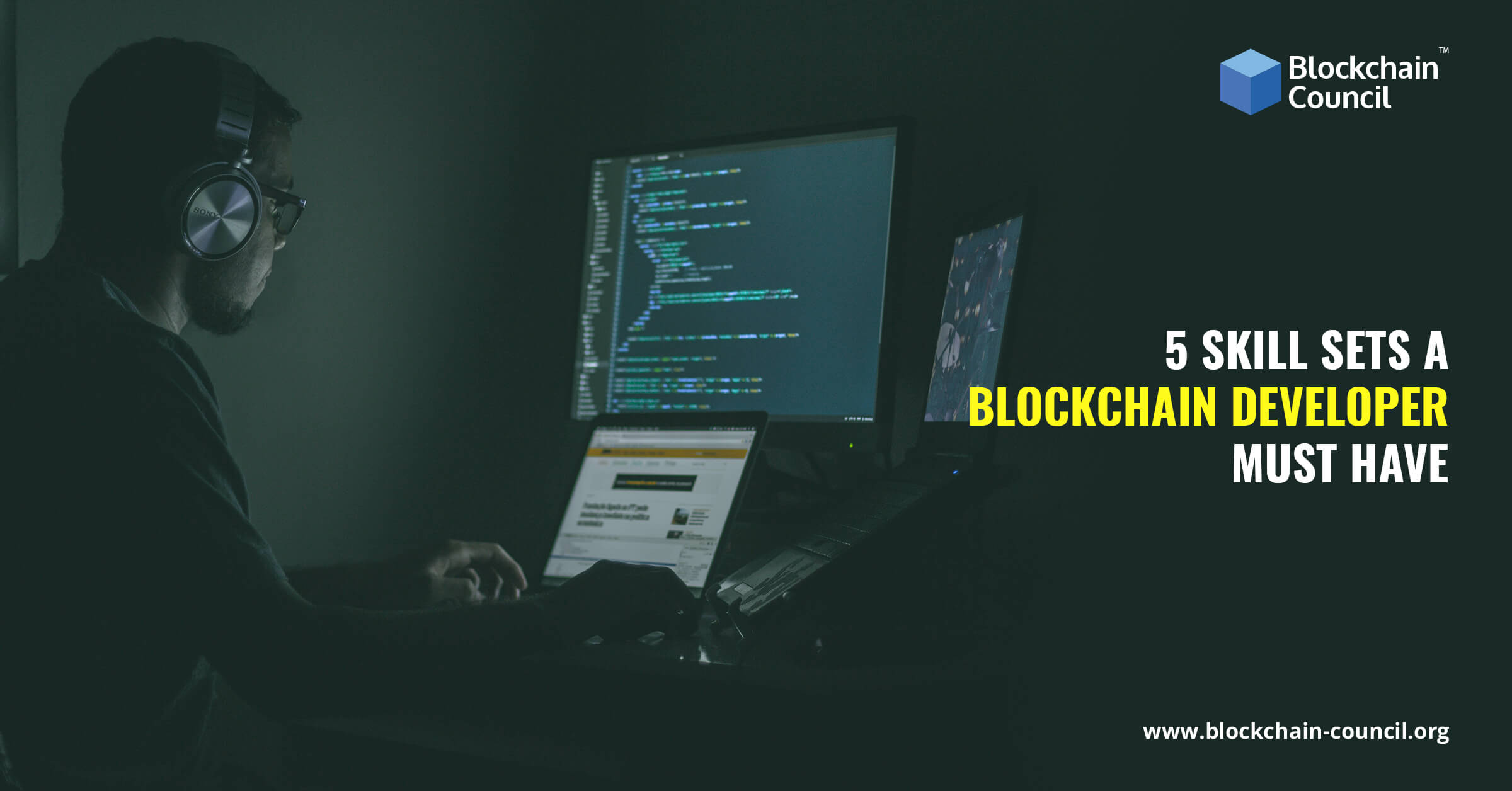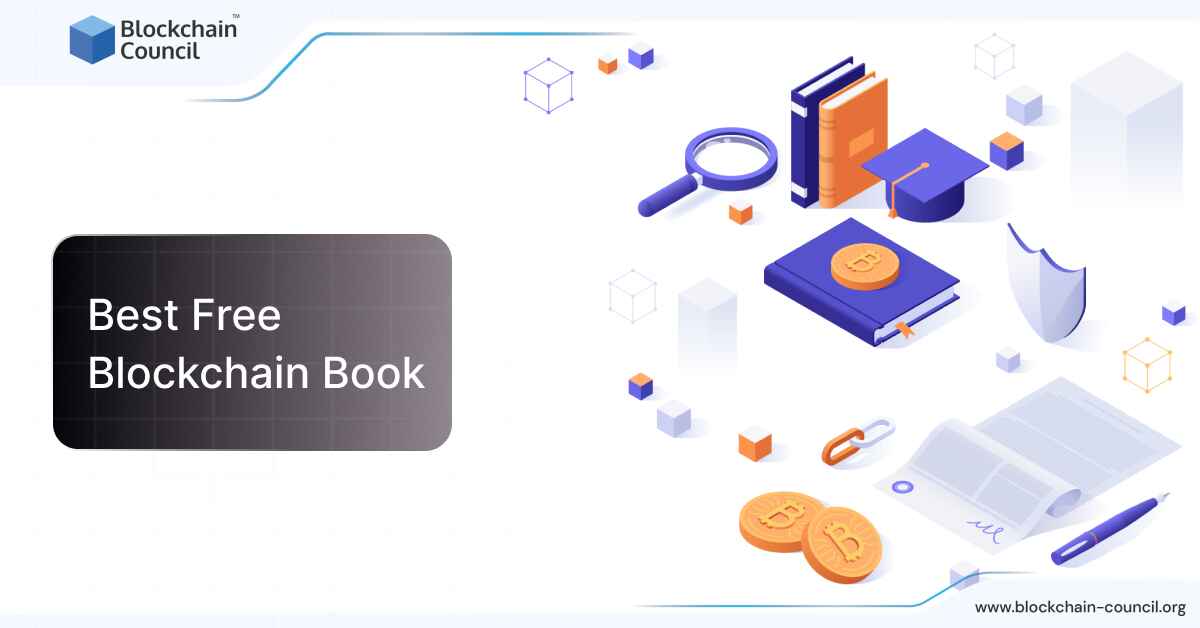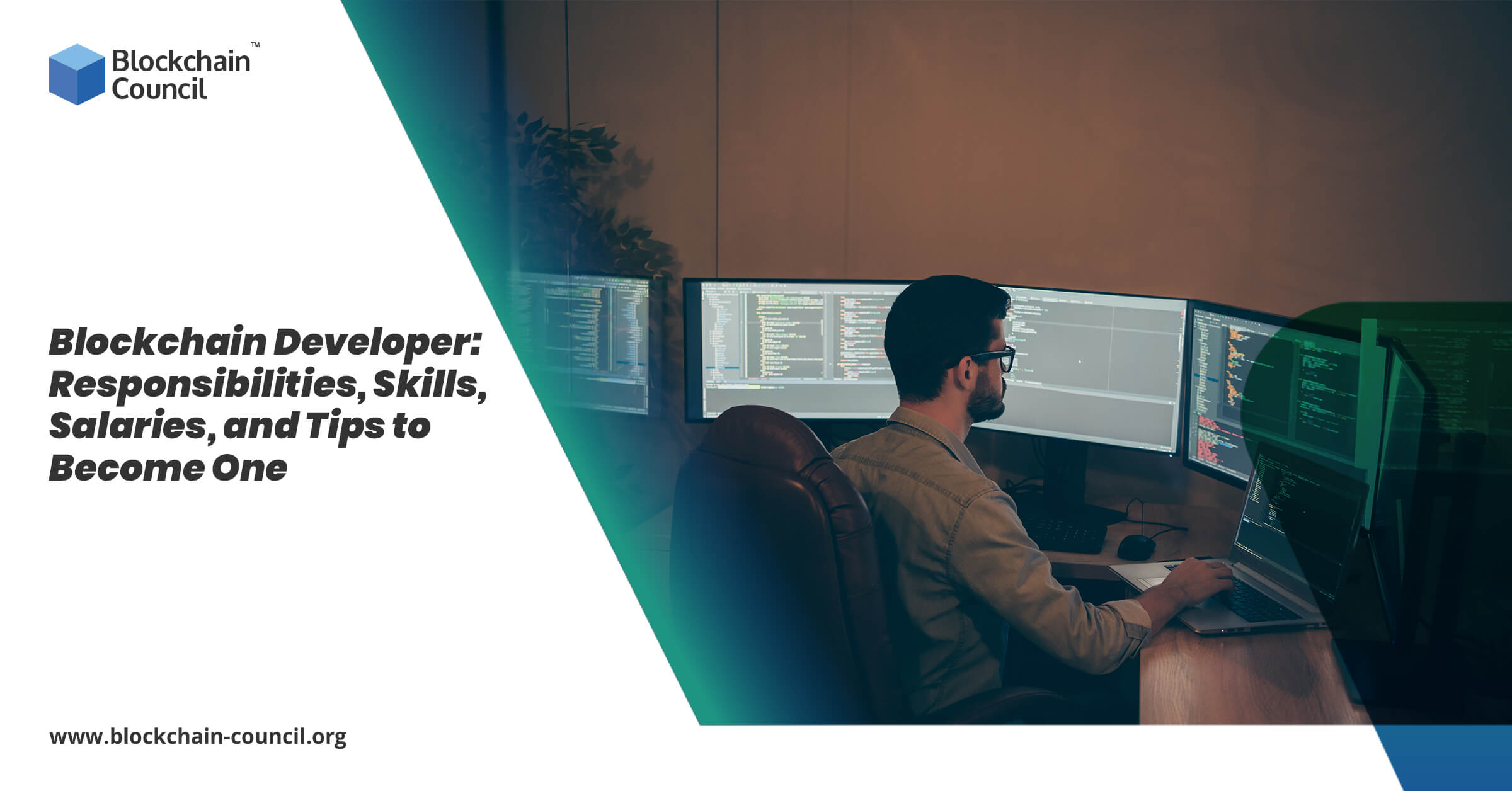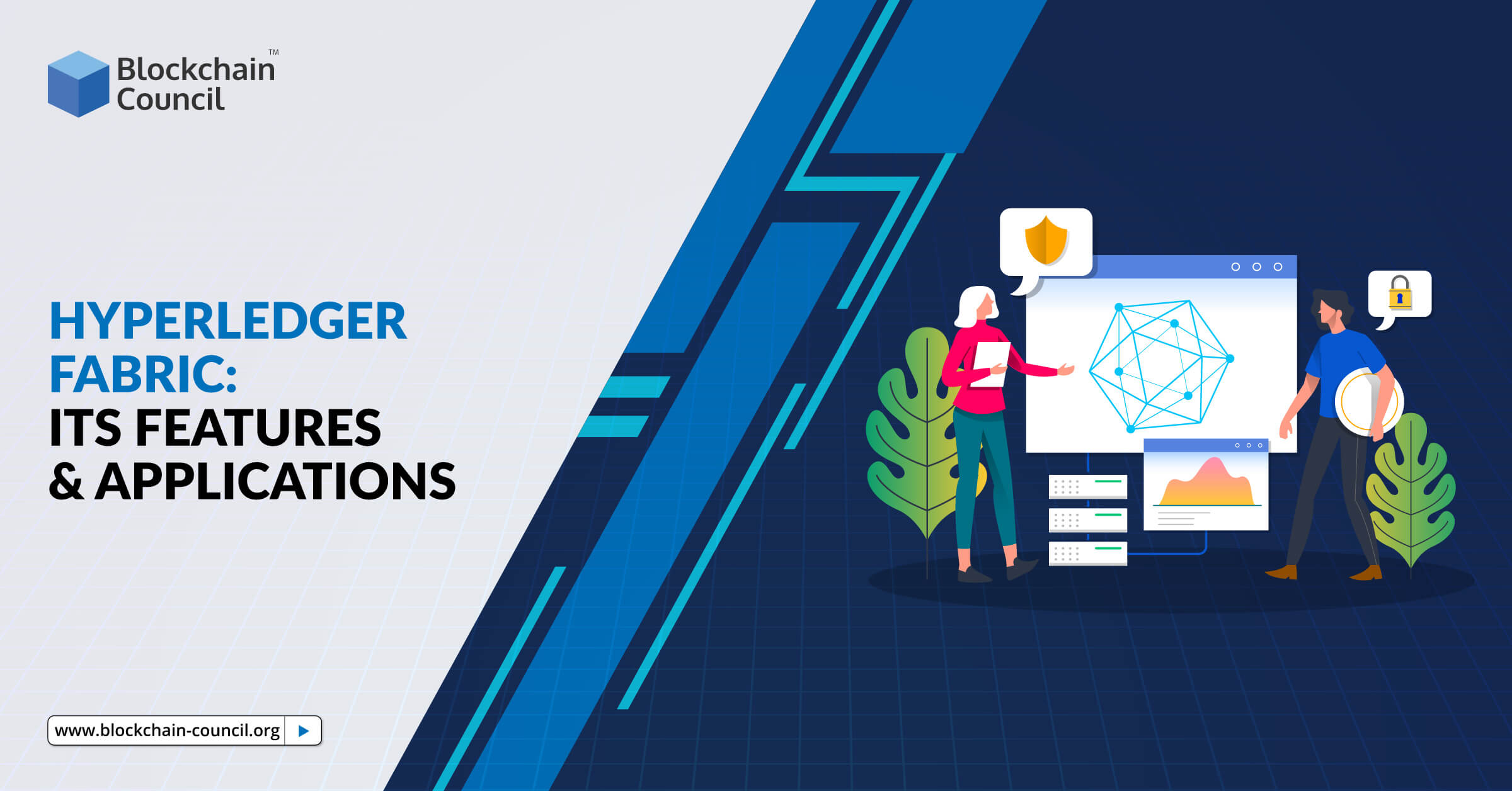
- Toshendra Kumar Sharma
- March 24, 2022

Since we all know that cryptocurrency and blockchains have gained a lot of attention in the last few years, it is wise to say that every other company in the country is looking to adopt them for their respective operations. Blockchain is undoubtedly the true hero of the event because it is the fundamental premise that allows cryptocurrencies to function. Blockchain has laid the groundwork for revolutionary development, which is a specialized sector of advancement. This has resulted in a slew of new work prospects for techies and programmers. So, is there anything unique that one needs to learn or improve? This post will go through such questions in depth to aid you in obtaining a better understanding.
Top Five Skill Sets Required for A Blockchain Developer-
Because Blockchain is such an emerging concept, no single person could pretend to be a master in every Blockchain developing skill. So, for this reason, we will talk about five top skills that are essential for any Blockchain Developer.
-
Data Structure-
Data Structure is the first essential skill that a Blockchain programmer should have. For the advancement and deployment of systems, blockchain engineers must engage with the data structures skill promptly. The entire Blockchain system is made up of data structures. Moreover, we can also say that a block is indeed a data structure. Because of their encapsulating data structure and the public ledger functioning as the Blockchain, blocks behave as groups of transaction activities associated with the open register.
Data structures are amongst the most critical Blockchain abilities since they aid in comprehending the underlying behavior of the most primary element in Blockchain, the block.
In the Blockchain Platform, some blocks consist of a header. Now, this header is much smaller than a block. Knowing about data structures will aid in the development of a solid basis for grasping complex topics more quickly and effectively.
Let’s see the working of data structure in Blockchain-
According to the blockchain structure, a unit of information collected within a block can be denoted by any sort of value. It could be a property, a piece of a corporation, a computerized proof of ownership, an election vote, or something else entirely. The information is encoded as well as saved in the block. The encrypted identification of the transmitter and recipient are also stored in a digital encoding block. The characteristics of the sellers and buyers, for instance, will be included in a league of e-commerce operations.
In a Blockchain, each block seems to have a hash responsible for defining the block and its contents. Any modifications made within a block will modify the hash. As a result, a hash generally identifies block modifications. In contrast, a block includes the preceding block’s hash. Consider a blockchain with three blocks: the 3rd block has the hash of the 2nd block, while the 2nd block contains the hash of the 1st block. Any modifications to any block can cause the hash of that particular block to modify, rendering the entire chain incorrect. A hash function is an excellent tool for determining information modifications in blocks.
-
Smart Contracts-
For all prospective experts, smart contracts are quite a challenging approach among the other Blockchain skills. Newcomers in Blockchain should be aware that smart contracts have been a popular concept in the business since the launch of Ethereum. In reality, all Blockchain platforms aspire to use smart contracts in their favor.
Smart contracts allow for the exchange of goods and services, avoiding the use of a middleman. Smart contracts are mainly performed if all individuals engaged in the transaction have met their contractual obligations. The decentralized structure of Blockchain contributes to the productivity of smart contracts.
Let’s see the working of smart contract in Blockchain-
Basic “if/when…then…” lines are put into the program on a blockchain to make intelligent contracts run. When preset circumstances are satisfied and validated, the activities are carried out by a system of computers. These activities could also include transferring payments to the appropriate parties, certifying a vehicle, providing alerts, or delivering a ticket. When the payment is made, the blockchain is revised. That implies the operation can’t be modified, and the outcomes are only visible to those who have been given access.
There could be numerous specifications as required in a smart contract to convince the parties that the operation will be executed correctly. Members must acknowledge how activities and associated data are displayed on the blockchain, decide on the “if/when…then…” standards by providing those activities, investigating all possible exceptions, and designing a mechanism for handling issues to set the conditions.
Let see how it makes our transaction safe. Blockchain transaction data are encoded; they are challenging to breach. However, One of the primary purposes of using a smart contract is for its top-notch safety. Furthermore, as each transaction on a distributed network is linked to the preceding and following entries, cybercriminals would have to change the chain to alter a data item completely. A programmer could then code the smart contract. However, firms that use blockchain for trade progressively provide frameworks, web applications, and other digital tools to make intelligent contract construction easier.
-
Cryptography-
Cryptography is a methodology for designing procedures and algorithms to prevent a foreign entity from reading and learning content from personal messages throughout a communication session. Kryptos and Graphein are two old Greek concepts that mean “disguised” and “to record,” respectively, are also used in cryptography. Cryptography is defined by several words, which are as shown below:
- Encryption –
Encryption transforms plaintext (ordinary text) into ciphertext (which is a random sequence of bits).
- Decryption–
Decryption converts an encrypted message into unencrypted text, which is the opposite direction of encryption.
- Critical–
A little bit of data necessary to trigger the cryptographic algorithm’s outcome is key.
- Cipher:
A cryptographic procedure that converts plaintext to an encrypted message using a mathematical algorithm.
Let’s figure out how many types of Cryptography are there-
To comprehend cryptography in blockchain, one must first understand the various sorts of cryptography. Cryptographic methodologies can be performed in three different manners:
- Symmetric-Key Cryptography–
It is an encrypted approach where we only use a unique key. This shared key is being used in both the encrypting and decrypting processes. The challenge of safely passing the key from the sender to the recipient arises when using a unique standard key. Secret-Key Cryptography is another name for it.
- Hash Functions–
Hash functions are a sort of encoding that does not require keys. It generates a hash code of a defined length from data using a cipher. The meanings of text format are complicated to derive from the ciphertext.
- Asymmetric-Key Cryptography–
In this process, only a pair of keys are used. Those keys are an encrypted key and a decrypted key. Both of these keys are referred to as the public key and a private key, accordingly. This algorithm generates a key pair consisting of a private key and a unique public key, both of which are obtained by using the same process. Public-Key Cryptography is another name for it.
- Asymmetric–
Essential methods and hash functions are the two main types of cryptographic techniques used in blockchains. Hash functions are employed to give each member the capability of a single opinion of the blockchain. The SHA-256 hashing method is commonly used in blockchains as a hash function. Hash functions play an essential part in connecting blocks and ensuring the authenticity of the information kept within each block.
-
Interoperability skills –
The potential to view and collect information across many blockchain systems is known as interoperability. For instance, if someone sends data to some other blockchain, will the receiver read, understand, and respond to it with minimal effort? Unfortunately, this is not achievable at present because information cannot be shared across the Bitcoin and Ethereum blockchains.
One of the most basic ways to achieve interoperability between blockchains is to make data capacity transfers easier. This is accomplished by using application programming interfaces (APIs), which are developed to accommodate information to be exchanged with each other. APIs are a well-known tool that doesn’t usually necessitate particular blockchain programming expertise to use. On the other hand, APIs do not require a management structure, which makes them accessible and convenient and a wrong long-term solution for organizing interoperability. They necessitate one-to-one connection between blockchain platforms, which is not efficient and increases friction to teamwork by introducing a commercial discussion between the systems. APIs deliver data contents throughout platforms at that moment, but they don’t necessitate a cross-platform verification of consensus methods. To put it another way, it’s entirely feasible that data transmitted from one system was not validated by a simple blockchain process beforehand.
Considering those disadvantages, developing a data format as soon as feasible is the best strategy to facilitate interoperability in areas where blockchains are still widely scattered. There must be a fundamental conceptual model for achieving scaled interoperability. But if it is not available in the essential elements of the technology stack, it must emerge from the data stream directly.
-
Blockchain Architeture-
Blockchain architecture is evident Blockchain expertise on a portfolio that will attract attention. Blockchain architecture is a crucial idea in Blockchain that all experts should be familiar with. It’s critical to comprehend the importance of a ledger in Blockchain, the definition of consensus, and how smart contracts function.
Three forms of Blockchain architecture includes private architecture, consortium architecture, and public architecture, must all be mastered.
A public blockchain format makes that everyone who wants to be involved can access the information and use the platform (e.g., Bitcoin, Ethereum, and Litecoin blockchain systems are public). All information is accessible to the people in a public blockchain, meaning anyone can participate in the entry process. But at the other aspect, this is inefficient because it takes a long time for each additional entry to be accepted into the blockchain infrastructure.
Unlike public blockchain technology, private blockchain technology is only managed by members from a single business or approved clients who have been invited to participate. Because it is managed by a single organization and has more anonymity, a private blockchain is more centralized. A public blockchain, on the other hand, is open-ended and, therefore, decentralized.
Compared to private blockchain systems, the timeframe for single transaction activity on a public blockchain is far less eco-friendly because it demands a large quantity of computing power.
Now comes the consortium architecture, which is not decentralized, and all network participants have complete control. As a result, consortium architecture is appropriate for use cases involving multi-organizational groupings. The Public Blockchain architecture is the most decentralized, allowing anybody to participate in the system by executing transactions and mining.
Some components of Blockchain Architecture-
- Node – it is a user of blockchain architecture.
- Block – it is a data structure.
- Chain – a series of blocks in a precise order.
- Miners – a particular node involves in the block verifying process.
Conclusion
As you can see, the top Blockchain professions list is exciting and extensive. Because it is not a database technology, Blockchain demands you develop a more expansive and better set of abilities. The abilities listed above will help you build a solid foundation for comprehending all Blockchain ideas and best practices. If a question arises in your mind about how to become a blockchain developer, then your first step should be to learn all the skills mentioned above. You can go for online courses or even can join any institute to get proper course certification. Blockchain Council is one such institute we would recommend you to checkout.
If you want to keep up with the trends of blockchain industry, join our communities on Discord, Reddit and Telegram.





































































 Guides
Guides News
News Blockchain
Blockchain Cryptocurrency
& Digital Assets
Cryptocurrency
& Digital Assets Web3
Web3 Metaverse & NFTs
Metaverse & NFTs
